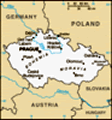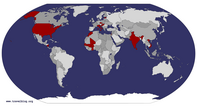Advertisement
Published: June 23rd 2017
Geo: 50.0878, 14.4205
As we walked off our KLM flight from Ghana to our lay-over in Amsterdam, our jaws dropped as we expereinced a few moments of re-entry shock into the developed world. The stores were full of options and things, and things, and things to buy. The airport almost felt sterile it was so clean and organized. Yep, we were most definitely out of Africa.
We arrived in Milan for ten days of 24-hour running water and electricity...oh yeah, as well as rest and relaxation. Given the multiple times we have been at Jamie's sister and brother-in-law's place, Milan is no longer a foriegn city to us.
Our friends, Amy, Marc and nine month-old Aviv from Portland met us in Milan for three days of non-stop machiatto/ espresso drinking and gelato eating. Somewhat embarrasingly, though joyfully, we made a daily pilgrimage to Pinguino Blu, Jamie and Justin's 2006 Best Pick for Gelato in Italy. Well, at least we got our calcium.
Between bouts of overindulgance, we managed to hit the summer sales to replace clothes threadworn by too much handwashing. We also started planning the last leg of our trip.
One of our favorite places in Italy is in Sandro's home town Asola.
We took a weekend trip out there to see his family - we went to a local saints day festival - for Santa Margarita where we ate local food and Jamie danced with Bruno (Sandro's Dad) to the Waltz. We also cooled off by spening time at their pool and drinking asti spumate (sparkling white wine) at the Liberty - the old bar in the town's square. We felt like locals when one of Sandro's friends recognized us while we were having a drink in the bar (sans Barb and Sandro).
After Italy, we headed to see more friends in Germany. Michael and Dorothea, and their two children, Sofie and Jonathan, live in Gottingen, a wonderfully quaint town of 120,000 people.
Gottingen isn't home to any tourist attraction, which perhaps makes it...well...such an attractive place to visit. On several mornings, we meandered on cobblestone streets and allys. Walking through town, we relished our newly-found anonimity. Nobody pestered us to buy trinkets nor did folks try to cheat us.
Clearly, this prosperous university town had its eye on the future. Interspersed among churches, bakeries, and other traditional establishments in the orderly 700 year-old buildings, were bright mobile phone shops and Internet cafes. Gottingen's
energy, optimism, and livability reminded us of our own Alberta Arts neighborhood in Northeast Portland.
After a few days of relaxation and fun (engaging in backyard water fights with four year-old Jonathan and three-year old Sofie), the Ruehlmann family graciously showed us Berlin, the capital of reunited Germany. Justin, who had visited the communist section of the city in 1986, scarcely recognized it. Replacing the drab, Orwellian facades of that era were the storefronts of uber-luxurious companies like Cartier and Dolce & Gabana.
Yet the dark past has not been forgotten: smack dab in the middle of the city, on land worth millions of Euros, is Germany's main, recently-opened Holocaust memorial. Jarring the opulence of downtown Berlin (perhaps intentionally), are hundreds of plain, grey concrete blocks on a football field-sized area. Clearly, the contrast is intended to be a haunting reminder of an event that should not be forgotten.
Both Berlin and Gottingen, in differing ways, seemed emblematic of Germany's newly-found confidence. Michael told us that for the first time in his life, people proudly displayed German flags on their houses and cars. The whole country was still glowing after its wildly successful hosting of the World Cup soccar chapionships, which
was held just a few weeks before our arrival.
After a week of German beer and sausage consumption, we took an overnight train to Prague in the Czech Republic. Our friends Matt and Petra Gelbart and their newly adopted son, Patrik, graciously opened up their apartment to us.
The Gelbarts are not here as tourists, though Matt had been a great guide by taking us around Prague and showing us things that we would have missed had our noses been buried in a guide book.
Instead, they are here to joyfully conclude a process they started nearly two years ago - the adoption of little Patrik. Because of Petrta and him, we started to learn about the fascinating world of the Roma people.
Roma (known to most Americans by the derogatory name of "gypsies"😉 have been a part of Central European history for 1000 years, ever since they migrated across the Russian steppes from India. They maintain some of their South Asian roots beyond just their skin color; for instance, the Romany language has the Punjabi language of India as its closest relative. Over the centuries and even today, the Roma have been ostrasized and maligned by Czech society as well
as others in this region. Despite this, they maintain a vibrant tradition of oral history and song. Indeed, they were the second group most targeted by the Nazis for complete extermination in Europe. Amazingly, Petra's ancestors were among the mere 500 Roma left in Czech after 1945. In addition to adopting a Romany child, Petra is somehow finding time for research for her PhD thesis on music teaching in Czech schools.
We are here during the height of tourist season; one could easily get swept away by all the crowds that flank the hot spots of the city. However, it is easy to get away from the crowds by slipping down some alley way to see where it leads. Justin has noted how much more touristy (and expensive!) Prague is now than it was when we first came in 1997. Sure enough, his "tourism barometer" - an indication of how touristy a place has become - went haywire when he saw Czech's first- TGI Fridays. Unlike Germany, Starbucks has not made inroads...yet.
In strolling the local Tesco (a Walmart-like megastore), Justin was reminded of an event in his childhood: 25 years ago, his father hosted a group of Russian physicists in
San Diego. The scientists were so astounded by the incredible selection of groceries in the local supermarket that they videotaped the vegetable aisle to show the folks back home in the USSR. To think that people in formally communist Czech now have the same choices. Of course, they also have many of the problems that plague the United States and Western Europe. But the difference between then and now is incredible.
Prague is a beautiful city with a mixture of art nuveau, baroque and gothic architecture mixed together. You can walk down the same street ten times and each time you will notice something new- like a statue of a guy hanging off the roof by a pole, or a gargoyle threatening to spit on you as you pass by. One could go wild here buying all types of - incredibly expensive - souveniers. We are not tempted; the thought of carrying anything more than we have to in our packs for the next three months is a huge deterrant.
We hopped on a bus to the Bohemian town of Cesky Krumlov. Krumlov is a nice break from the bustle of the large cities. The main draw is the picturesque castle that
looms over the old town's cobbled, windy streets and the river, where one can take a lazy cruise in a kayak or canoe. (For Jamie, who was freezing in the 70 ·F weather after nine months of living at 90·F+, getting wet was not an option.) We booked ourselves into a hostel, sharing a room with four other people. The party atmosphere (as demonstrated by a free keg of delicious local beer on Wednesday nights) and young backpackers that make up the clientele made us feel old. Hosteling is the cheapest option for accomodations in Europe and they are fun if you are 18, but at our age, it makes us feel like we are back in college. The sign on the bathroom that said, "No wanking in the shower, it wastes too much water - unless you are quick," didn't hold much charm for us.
Hostels aside, we have been hiking around the town and surrounding forested hills, enjoying the river views and relaxing under the castle's gaze. We visited an old Baroque theater that is one of two original theaters of this kind that remain in Europe. All the others have all burned down because of the errant
use of the lighting technology of the day - candles.
What was fascinating about the theater was the limited amount of scene changes and special effects that could be used in plays the 1700's, leaving it up to the viewer to use his/her imagination to fill in a scene. Use of imagination is something that modern day cinema has taken away form the viewers.
A major upset to us (and much less importantly, to our plans) is the current situation in the Middle East. We had intended on spending the last 8-weeks of our journey ambling through Syria, Jordan, Israel, and Lebanon... Clearly, the last destination will not happen and the others are still up in the air.
We noted, with grim irony, that we're planning to spend several weeks traveling in Bosnia, Croatia, Montenegro, and Hertzocrovenia - places that were definitely off-limits to tourism just a few years ago.
So, we head off for Poland and then the Baltics before we hit our furthest point north on this trip - a visit to St. Petersberg, Russia before heading south to the Balkins.
Advertisement
Tot: 0.09s; Tpl: 0.015s; cc: 7; qc: 45; dbt: 0.0503s; 1; m:domysql w:travelblog (10.17.0.13); sld: 1;
; mem: 1.2mb
















